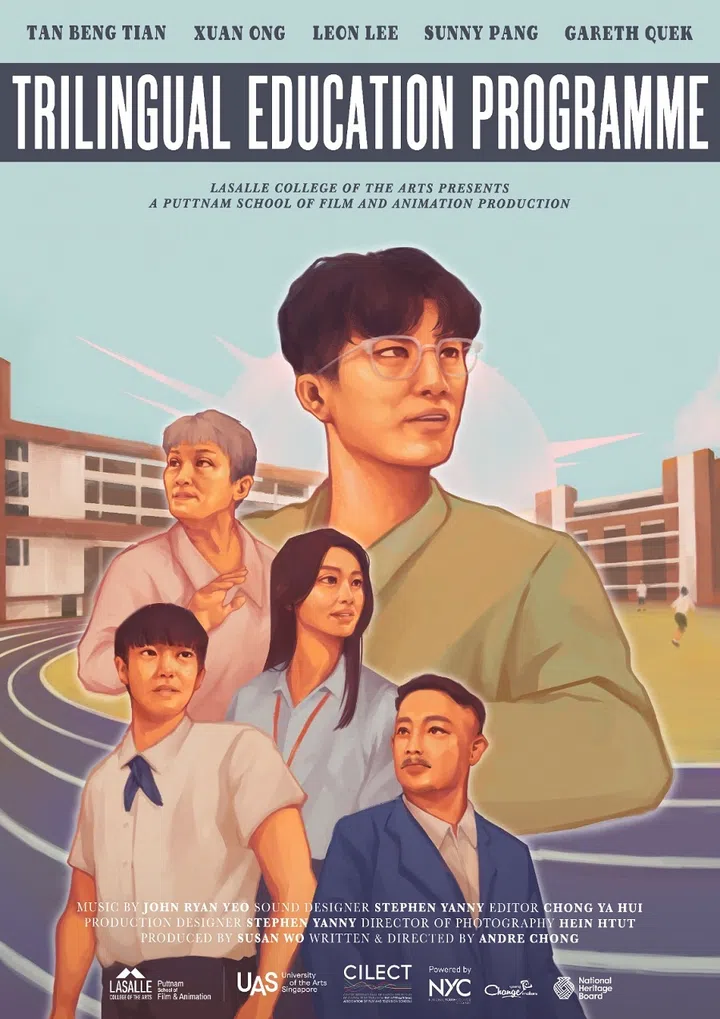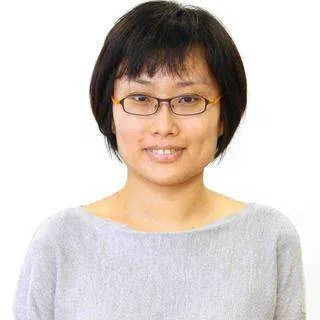[Big read] Singapore youths reconnect with Chinese dialects
Lianhe Zaobao correspondent Koh Hsiang Yu looks at why some people and organisations in Singapore are willing to go against the tide to preserve different Chinese dialects.

Andre Chong, 25, is a graduand at LASALLE College of the Arts. As he was not fluent in the Hakka dialect, he often encountered trouble communicating with his grandparents. Now that they have passed on, Chong regrets this shortcoming.
He noticed that many of his peers also shared the same thoughts, so when he was coming up with ideas for his final year video project two years ago, he decided to explore the topic of dialects. Recently, he and five other classmates shot a 20-minute film entitled Trilingual Education Programme*.
The film is set in 2035 in a fictional world where Singaporean Chinese students have to learn a Chinese dialect in school in addition to Mandarin and English. Those who are not proficient in dialects are at a disadvantage and struggle to adapt.
Reconnecting with dialects
Chong, who wrote the script and directed the film, used this alternative reality to remind viewers to empathise with those who feel out of place in today’s society because they can only speak dialects, and to encourage young people to learn dialects and treasure their time with their grandparents.
Almost the entire cast spoke dialect in the film. Even though Gareth Quek, 18-year old student from Raffles Institution, only played a supporting role, his spoken Hokkien was one of the most fluent. Worried that dialects would disappear from Singapore, Quek founded the Raffles Dialects interest group with several schoolmates three years ago to promote their learning in school.
In their own ways, both Chong and Quek are advocating for the preservation of dialects. Several such projects initiated by youths have popped up over the recent years.
The Singapore Census of Population 2020 found that among the local Chinese population aged five and above, 47.6% spoke English most frequently at home, followed by 40.2% and 11.8% for Mandarin and Chinese dialects respectively.

Associate Professor Aw Guat Poh, assistant head (Chinese) of the Asian Languages and Cultures Academic Group at the National Institute of Education (NIE) in Nanyang Technological University (NTU), feels that this is a natural phenomenon and it reflects attempts by some youths to trace their roots.
At the launch of the Speak Mandarin Campaign in 1979, its slogan called for Singaporean Chinese to “Speak More Mandarin, Speak Less Dialects”. More than four decades since, Chinese dialects are slowly disappearing from everyday life in Singapore as fewer young people know how to speak them.
Entering a new phase of language development
Aw categorised language development in Singapore into two phases. The bilingualism policy implemented in the first 50 years of nation-building satisfied the developmental need for common ground amid diversity as speakers of different Chinese dialects were able to use Mandarin as a common tongue. This promoted unity and faciliated communication in the early years.
As Singaporean society becomes more inclusive, Aw observed that people are now less likely to stigmatise certain languages.
“But following 50 years of bilingual education, language use in Singapore has essentially stabilised, with English being used primarily alongside certain mother tongues. Based on census findings, this trend is unlikely to be reversed, so we have moved into the second phase of allowing diversity amid similarities where most locals speak two languages, with each race preserving its language characteristics,” added Aw.
Today, English has replaced Mandarin as the most commonly spoken language at home for Singaporean Chinese, while the use of Chinese dialects is low. The Singapore Census of Population 2020 found that among the local Chinese population aged five and above, 47.6% spoke English most frequently at home, followed by 40.2% and 11.8% for Mandarin and Chinese dialects respectively.
Aw is heartened to see young people proactively learning or promoting Chinese dialects. She said, “As a multicultural and multilingual society, this is our advantage and what makes us special. Language is a cultural asset, and knowing one more language is like having another pair of eyes.”

As Singaporean society becomes more inclusive, Aw observed that people are now less likely to stigmatise certain languages. At the same time, the government and public opinion have also become more tolerant of Chinese dialects.
Sew Jyh Wee, a lecturer at the National University of Singapore (NUS) Centre for Language Studies, also noticed that a number of undergraduates are interested in learning Chinese dialects and have even taken the initiative to canvass school authorities to offer such courses.
There were also some who enrolled to better communicate with their elders at home or those whom they might encounter at work in future.
Student-initiated dialect courses in NUS well received
In 2020, a group of NUS students approached university administrators to propose for Sew to teach a conversational Hokkien dialect course under the university’s Design-Your-Own-Module programme, which encourages students to design their own modules and explore knowledge outside their academic domains.
After the course was given the go-ahead, Sew was initially assigned a classroom that could accommodate 25 students, but was eventually allocated a bigger classroom as 41 students had signed up.
Subsequently, he also started a conversational Cantonese dialect class after students made the proposal to the school authorities. The class attracted nearly 40 students. Sew has since offered the module each semester and the take-up rate has been very encouraging. There were 55 students in the most recent course that ended in March. He is optimistic that the course would continue to draw interest.
Based on Sew’s observations, some students signed up simply out of interest for the dialect, while others wanted to learn more about their own culture. There were also some who enrolled to better communicate with their elders at home or those whom they might encounter at work in future. Students with this in mind include those majoring in social work or pharmacy.

Of course, there were also students who took the course for practical reasons. Sew pointed out that while academic credits are awarded for the module, enrolled students would only receive a “Completed Satisfactorily” or “Completed Unsatisfactorily” grade that does not affect their overall grade, hence its popularity with students.
Regarding the concerns over the future of Chinese dialects in Singapore, NTU’s Aw believes that in multilingual Singapore, dialects have fused naturally with other languages to take on new forms. Today, this comes in the forms of Singaporean Mandarin and Singlish.
Aw added, “Singlish is a new language variant that arose from the mixing of several different languages, and it contains lexicon and even grammar borrowed from Chinese dialects. This is an interesting phenomenon that is still evolving and certainly worth studying further.”
While LASALLE’s Chong is somewhat reassured that the Chinese dialects will not disappear completely as they fuse with Singlish, he still encourages young people to become more proficient in Chinese dialects if they can. This would enable them to better communicate with the elderly and learn more about their ancestral cultures.
“There is not much of an environment to use dialect in Singapore. Through pop culture, our youths have way more chances to encounter Korean and Japanese than Chinese dialects.” — Gareth Quek, 18-year old student, Raffles Institution
Teaching Chinese dialects to general public
While most Singaporean youths are indifferent towards Chinese dialects, advocates for their preservation remain committed to promoting dialect learning through engaging activities, despite the size of the interested group.
The Raffles Dialects interest group promotes Chinese dialects on campus through learning from one another. Since last August, the group has collaborated with the Bishan Public Library to impart basic Chinese dialect conversational skills to the public. This has provided the group with the impetus to carry on.
One of its founders, Quek, is in his second year of junior college and is set to graduate later this year. He has started thinking about outreach projects for the group, including movie screenings or music performances for people to make casual contact with Chinese dialects.
Quek did not speak much dialect as a child. He gradually became more proficient through listening to his family elders as they conversed in the Teochew and Hokkien dialects, self-learning using free online resources, watching movies by local director Jack Neo, and attending Teochew lessons at the Teochew Poit Ip Huay Kuan clan association.

Quek admitted that very few of his peers share his fervour in dialect learning. In fact, most of them do not see much purpose to it. Quek said, “There is not much of an environment to use dialect in Singapore. Through pop culture, our youths have way more chances to encounter Korean and Japanese than Chinese dialects. Realistically, our project may not last very long, but we hope to come up with new and interesting activities that can draw attention and allow us to go further.”
Quek also noticed that the Chinese dialect courses offered by some clan associations are mainly taught in Mandarin and at a cost. To better cater to the learning needs of younger students, he and his group mates provide free classes using a mix of English and Mandarin.
The strength of the Raffles Dialects interest group has grown from five to 12 members. And the five to six sessions of online or in-person lessons that it jointly offers with the library sees enrolment ranging from 13 to 25 students, with young working professionals forming the bulk.
When he was volunteering at a nursing home, he saw that some elderly residents there who could only converse in dialect were having a tough time expressing their needs to the foreign nursing assistants who only spoke English.
In 2018, 40-year-old Eugene Lee and his wife founded LearnDialect.sg. Lee picked up the Teochew dialect from family elders in his younger days and subsequently became adept in the Hokkien and Cantonese dialects. When he was volunteering at a nursing home, he saw that some elderly residents there who could only converse in dialect were having a tough time expressing their needs to the foreign nursing assistants who only spoke English. The experience planted in him the idea of teaching Chinese dialects in English.
Lee, who used to work in the finance industry, observed that more students are interested in Chinese dialects over the last few years. Consequently, he has received more queries on dialect-related topics, but it remains to be seen whether this can grow into a trend.
Meanwhile, fewer people are now willing to pay for dialect classes. During the Covid-19 pandemic, Lee conducted up to two learning workshops every month, but the frequency has dropped to one every two to three months. He pointed out that this may not be a bad thing as it could mean that people now have more avenues to pick up Chinese dialects.

Lee remains upbeat and is prepared to continue offering his courses despite the challenges. He said, “I feel that a certain proficiency in the local Hokkien or Cantonese dialects would give one a more in-depth understanding of local dialect culture.”
Academic seminar on Hokkien dialect pedagogy
Singaporean Hokkien dialect differs greatly from those in other places as it contains lexicon from other local Chinese dialects, Mandarin, English and Malay.
The NUS Department of Chinese Studies and Asia Research Institute are jointly organising an academic seminar in September to explore teaching methods suitable for the local context to effectively pass down the Hokkien dialect.
The seminar is part of an initiative to promote the Hokkien dialect led by Professor Kenneth Dean from the Asia Research Institute and Department of Chinese Studies at NUS. Local and foreign scholars, organisations and individuals involved in teaching dialects have been invited to attend the seminar.
Besides identifying Hokkien dialect teaching methods and materials that align with the needs and cultural background of Singaporeans, the seminar will also trace the spread and development of the dialect in history, as well as its diverse characteristics in different eras and regions.
They will also collaborate with clan associations and societies from Singapore and Malaysia to conduct a series of masterclasses at the end of the year to share the outcomes of the seminar.
Hokkien in everyday Singapore
While Hokkien used to be the lingua franca in local Chinese communities, it is now generally considered a grassroots tongue.
Hing Jia Wen, a postdoctoral fellow at the Asia Research Institute and a member of Dean’s Hokkien initiative, told Lianhe Zaobao that her team hopes to show young people from the dialect gap generation that Hokkien can be both sophisticated and easy to understand, and how it has permeated all aspects of everyday life, including street names and Singlish.
The first activity under the initiative, a seminar entitled “Hokkien in Everyday Singapore”, was held at the end of April and attracted around a hundred attendees. The organisers will also be running a series of conversational Hokkien classes for NUS students and the public, with the first round scheduled at the end of June and the second for December.
... 40% of temple management continue to use Hokkien or other dialects during their meetings, with a further 30% using Mandarin, and the remainder using other languages such as English.

According to The Singapore Census of Population 2020, among residents aged five and above, the percentage of those who speak a Chinese dialect most frequently fell from 14.3% a decade ago to 8.7% in 2020.
Nonetheless, Dean highlighted that Chinese dialects are still frequently used in settings with more elderly folks in attendance and during important traditional Chinese ceremonies.
Dean led his team of researchers in a recent survey of around 300 Chinese temples and they found that 40% of temple management continue to use Hokkien or other dialects during their meetings, with a further 30% using Mandarin, and the remainder using other languages such as English. While this shows the vitality of Chinese dialects such as Hokkien, Dean noted that their future is still uncertain.
For the conversational Hokkien classes mentioned earlier, the NUS team engaged Lee from LearnDialect.sg as the instructor. The classes are meant for beginners and would be taught mainly in English. Students pay an initial deposit of S$150 (US$110), which would be refunded upon completion of the course.**
Singaporean Indian student sings Cantonese songs
Ngo yi-ga sik gong gwongdungwaaa! (I know how to speak Cantonese now!)
In an email interview with Lianhe Zaobao, Yuknavell Thiyagarajan, a 24-year-old Singaporean Indian third-year student at NUS, used the above English transliteration to demonstrate his familiarity with Cantonese pronunciation.
Thiyagarajan is a computer science major in NUS who also minors in linguistics. Recently, he completed a conversational Cantonese course taught by Sew Jyh Wee at the university’s Centre for Language Studies. Now, he is able to converse in simple Cantonese and belt out Cantonese classics such as Beyond’s Sky (《海阔天空》) and Anita Mui’s Song of Sunset (《夕阳之歌》) during karaoke sessions.
“Learning Cantonese has been a new experience, and I hope to continue learning and growing like the sprouting crescent moon in the night sky.” — Yuknavell Thiyagarajan, a 24-year-old Singaporean Indian third-year student, NUS

Thiyagarajan’s mother tongue is Tamil. Influenced by his friends who are mostly Singaporean Chinese, he learnt to speak Mandarin and even took it as his third language subject in secondary school. He said, “Being born and bred in Singapore means being exposed to languages and cultures from southern China. However, I feel that I can further increase my knowledge in this aspect to strengthen my connections with friends, so I decided to take Cantonese.”
Thiyagarajan feels that his Mandarin foundation has helped in his learning of the Cantonese dialect. He added, “Actually, Singlish has been an even greater help since it has similar grammar with the Chinese dialects and also modal particles such as ‘lah’, ‘loh’ and ‘aah’.”
He came up with the Chinese name “Wai Yuhk Ngau” (威玉钩) for himself after he started learning Cantonese, as its Cantonese pronunciation highly resembles that of his actual name, Yuknavell.
Thiyagarajan feels that his Chinese name is very meaningful as the phrase Yuhk Ngau is often used to describe the new moon in ancient Chinese poetry. He explained, “Learning Cantonese has been a new experience, and I hope to continue learning and growing like the sprouting crescent moon in the night sky.”
Thiyagarajan intends to stay in touch with Cantonese through consuming Cantonese media online and looks forward to using the dialect to interact with older folks in future.
*The trailer for Trilingual Education Programme can be viewed here: https://vimeo.com/949069781.
**Those interested to learn more about the conversational dialect classes at NUS can contact jw_hing@nus.edu.sg.
This article was first published in Lianhe Zaobao as “学生自发学方言 还参与推广 “有影无?”.



![[Photos] Fact versus fiction: The portrayal of WWII anti-Japanese martyrs in Taiwan](https://cassette.sphdigital.com.sg/image/thinkchina/3494f8bd481870f7c65b881fd21a3fd733f573f23232376e39c532a2c7593cbc)

